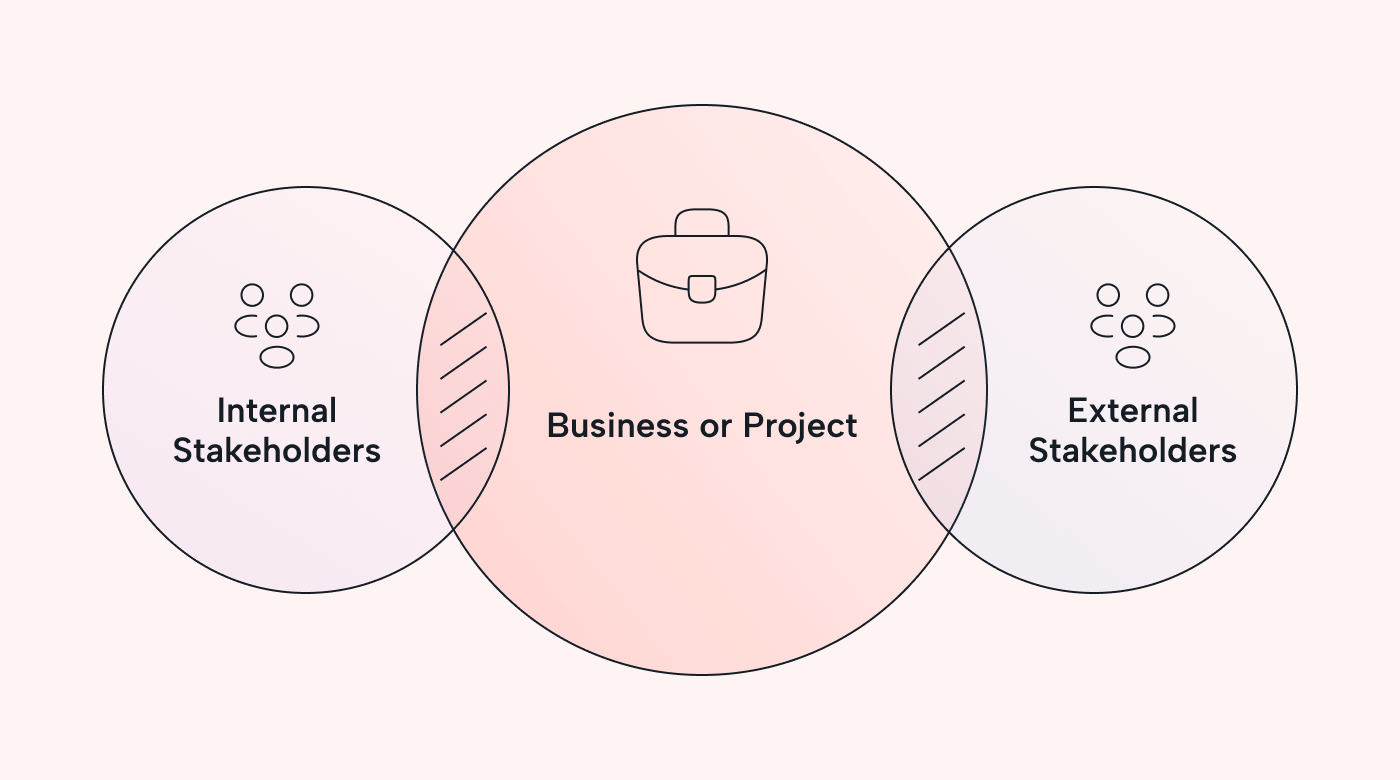Whether you’re running a business or a project, you’ll have external stakeholders. These are people who have a stake in your success or failure because it could be the difference between winning and losing themselves. The key is in the second word: stakeholders. They have a stake in your business or project.
Most often, external stakeholders will want you to succeed. But with competitors, your success might mean their failure, and vice versa. More about that later — for now, we’ll focus on external stakeholders who are invested in your success.
And the clue to why you need to nurture them lies in the first word: external. Because they’re not involved in the day-to-day of your business or project, they can offer an outsider's perspective. This helps you, as a business leader or a project manager, to stay focused on the big picture rather than getting lost in the details.
What is an external stakeholder?
It could be literally anybody. Government agencies, regulatory bodies, financial institutions, customers, suppliers, and even the public. These external stakeholders can have both direct and indirect influence on a company. And they’ll often have their own interests, needs, and expectations of you and your business or project.
Who are your external stakeholders?
External stakeholders are people or groups who aren’t directly involved in a business or project but can have an effect or be affected by it. But they’re valuable to you for their insight. This is because they’re on the outside looking in, where the bigger picture is much easier to see.
To be clear, they’re not completely detached. External stakeholders definitely have an interest in your success or failure, but they’re not directly involved in the day-to-day grind of your business or project.
Internal stakeholders vs. external stakeholders
Anyone who works with you in your business or on your project is an internal stakeholder (sometimes called a primary stakeholder). The most obvious ones are your employees, managers, and executive directors.
Your employees are invested in your business or project for the simplest of reasons: they want to be paid for their work (and sometimes because they love the work, too). You see them or talk to them every day, so you may think they’re your most important stakeholders. The same applies to executive directors and senior managers.
But their proximity can also be a disadvantage. Internal stakeholders often can't see the forest for the trees, meaning they’re too involved in the details to notice what’s important about the business or project.
 |
That’s where your external stakeholders come in. They’re not intimately involved in the day-to-day, so they do see the forest. Non-executive directors, shareholders, and other members of your business value chain all want the same thing that you do: success.
The types of stakeholders
Whether you're running a business or just a project, you'll encounter many different external stakeholders. And while there are many different types, there are two broad categories: those who can help you in your venture and those who, in doing their job, may hinder you. But none of them can safely be ignored.
Government agencies
One external stakeholder is shared with every business or project: Government. This key stakeholder can affect you positively or negatively at the national, state, or even city level. So it's likely you have a love-hate relationship with it.
Government agencies and departments develop policies and regulations to govern different business sectors. Their goal is to make sure that you're law-abiding and that you run an ethical business. Others collect taxes from you at the city, state, and federal levels.
All of them must be considered when you’re developing your strategies.
Regulators
The government also springs to mind if you think of regulators. They’re responsible for setting and policing standards in business or in an industry. The goal is usually to protect the public interest, promote public health and safety, and encourage fair and ethical business practices.
A good example is the Food and Drug Administration in the U.S. It regulates the production and distribution of food and medicines with strict guidelines for manufacturers. This helps ensure the safety and quality of products. The European Medicines Agency does a similar job in Europe.
But there are also regulators set up by businesses themselves. These are called self-regulatory organizations (SROs), whose role is to police their industries. They make sure that member organizations follow the rules and meet the standards agreed in each industry.
Customers
Probably the most obvious external stakeholders are your customers. As the people who use your products or services, their buying decisions have a clear impact on your bottom line. The adage applies here: “The customer is always right.”
But it’s important not to take that adage too literally. Yes, customers can be wrong, but even then, there’s always something you can learn from them to improve your business or project. The key is to build strong customer relationships, which help you to keep those customers. It also lets you support customers better and boosts your data collection efforts.
Suppliers and vendors
Your supply chain is another obvious but often overlooked place to find external stakeholders. Never forget that you are a customer for your suppliers and vendors, so the external stakeholder relationship goes both ways.
These are the people and companies that provide the raw materials, goods, or services you need. Without them, your business or project couldn't operate smoothly. You could face production delays, build poor-quality products, or even have stockouts. As it is with customers, good communication and a direct relationship is the key. You must always be approachable to them.
 |
Investors and shareholders
There’s a group of external stakeholders that’s often seen as hands-off. But the truth is that your investors and shareholders play a vital role in your business or project’s success. Apart from the financial support they give you, they usually have a lot of expertise and industry knowledge that can help you to make the right strategic decisions.
More importantly, they watch your overall performance like hawks because it affects the return on their investment. They'll monitor key financial indicators closely, things like revenue growth, profitability, and your stock price. They can also buy or sell your shares, influencing the price and market perception.
Also, the fact that they are involved in your business or project attracts other investors. It can boost your company's reputation and increase access to other funding sources.
The local community
Another often neglected stakeholder in your business or project is the community. This is where you have an office, a shop, a factory, a warehouse, or a service point. It makes you part of that community, and whatever you do there affects it.
And this is why community members and local organizations are important. They want you to support them, be environmentally sustainable, help them with social welfare, and protect the cultural heritage of the community. They worry about job creation, the quality of your goods and services, and growing the local economy.
If that sounds like a lot of giving with very little coming back, you're wrong. This group of external stakeholders helps you to keep tabs on developments and opportunities in the community. And a little bit of goodwill can go a very long way.
Competitors
It might seem counterintuitive, but competitors are key external stakeholders, too. Remember that your success in business or on a project will materially affect them. On the flip side, they could bring a competitive product or service to market. And could force you to adapt, delay, or even abandon your venture.
But there are also lessons to be learned, which is why you must keep a sharp eye on your competitors. By monitoring them, you might discover how to fix something you are doing wrong or spot opportunities to exploit weaknesses in their strategies.
Financial institutions
Shareholders usually provide the initial funding for a business or project. But they're not keen on funding your running expenses. You need banks and other financial institutions for that, which makes them external stakeholders in your venture.
These lenders don't have operational control over the business and typically don't have the know-how to add value. However, they do have a vested financial interest in your success because if you fail, their money could be lost.
 |
They don’t want you to fail, so their perspectives on your actions or planning can be very valuable.
Why are external stakeholders important?
Letting external stakeholders get involved in your decisions can minimize negative impacts. It can also help you make the most of the positive ones. For example, if you engage them in a new product launch, they could help you create a buzz around it.
The role of external stakeholders
Apart from being able to help you generate valuable media coverage, external stakeholders can also provide valuable feedback and insights. Through them, you can get a better understanding of customer needs and preferences. And you can use that information to refine and improve your products and services.
External stakeholders can also help you identify and manage the risks that could endanger your business or project. And their knowledge can offer educational value, while their experience can help you make better decisions.
Your board of directors
To be clear, your board of directors will include both internal and external stakeholders. The ones who are involved in the daily operation of your business will be too close to be considered external.
But your non-executive members were wooed for the value you thought they could bring. That could be contacts, specific expertise, experience, or anything that'll allow them to see things from a perspective different from yours. Remember, the primary role of a board of directors is to maximize profit and achieve a good return for investors.
Identifying and managing external stakeholders
The process is called a stakeholder analysis. When you conduct this exercise, it's important to first identify and then understand all the stakeholders of your business or project. This is where you'd do stakeholder mapping or build an influence and importance matrix.
Only then can you effectively engage with them, meet their needs, and build strong relationships with them. And doing that'll make a massive difference to the likely success of your business or project.
Rewarding your external stakeholders
As we’ve seen, different external stakeholders want different things from the relationship. To effectively share rewards among stakeholders, it’s critical to consider the stakeholder matrix.
The rewards are only ever intended to acknowledge the importance of their roles. Yes, they can include financial incentives, but usually, they’re exclusive benefits or simply recognition.
Your communications plan
The key to effective management is always communication. External stakeholders need to know what it is that you expect of them every step of the way. That requires constant and appropriate communication on the state of your business or project.
 |
And for that, you need a communications plan. This should define what information (and types of information) should be shared with whom, when, and how. Frequency is also important. You must tailor your communication to the needs of each external stakeholder.
If you want to extract the most value from them, they must feel involved, like they’re a critical and highly-valued member of the team.
Making the most of external stakeholders
All business is about managing stakeholder relationships with a wide range of people and organizations — many of them external to your business or project. To win, you must identify and manage those who’ll hold you back and find effective ways to reward those who’ll help you succeed.
Doing so will:
- Improve the effectiveness of your organization’s decision-making
- Create better relationships with stakeholders
- Help you avoid delays or roadblocks for your business or project
- Improve your risk management and accountability
- And foster trust and goodwill among your stakeholders
One way to accomplish this is with stakeholder mapping with Motion’s AI-powered tools. They can help you automate your stakeholder updates, track their activities, and manage your recurring meetings in one place.
Let Motion help you manage those stakeholder relationships. Try it for free today!






